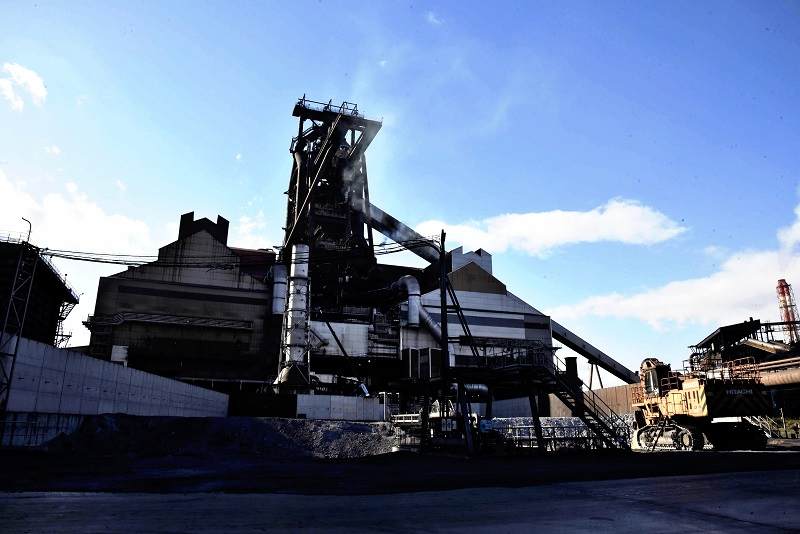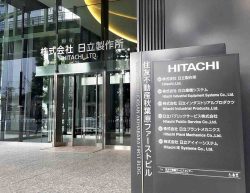
A blast furnace is seen in JFE Steel Corp.’s West Japan Works Kurashiki plant in Kurashiki, Okayama Prefecture, on Dec. 15.
15:42 JST, December 24, 2022
Major steelmakers are stepping up usage of electric furnaces, which emit less carbon dioxide than blast furnaces.
Decarbonization has become an important task for the whole of the steel industry, and the companies are speeding up the shift from blast to electric furnaces and the development of technologies for mass production with electric furnaces as realistic measures until the next generation of steel-making technologies can be established.
Making the switch
JFE Steel Corp. showed its West Japan Works Kurashiki plant to the press on Dec. 15.
The plant is located in an industrial area in Okayama Prefecture facing the Seto Inland Sea, and gray smoke billows out from its blast furnace, which is seen as a symbol of the steel mill.
JFE Steel is considering starting to shift from blast to electric furnaces by halting operations for one of its three blast furnaces and building a new large electric furnace sometime between 2027 and 2030.
It is the first time in Japan that a major steelmaker will switch out a blast furnace for an electric one.
“For decarbonization, it is important how many kinds of steel products we will be able to produce with electric furnaces,” said Masahiro Furukawa, head of the West Japan Works.
To build the new electric furnace, Masashi Terahata, executive vice president of JFE Holdings Inc., said investments worth “tens or hundreds of billions of yen” will be necessary.
JFE Steel plans to raise the output of its electric furnace at its Sendai Works plant in Sendai by 2024.
Such proactive investments in electric furnaces is being driven by strong demands from the government and client companies to actively work toward decarbonization.
Mostly blast furnaces
Traditionally, major steelmakers have laid the strength in their ability to produce high-quality steel using blast furnaces, and they still produce most of their products with such furnaces.
However, coal-burning blast furnaces emit massive amounts of CO2. In fiscal 2020, the total volume of CO2 emissions of the steel industry was 131 million tons, which accounted for nearly 40% of all emissions in the manufacturing sector.
Steelmakers have set a goal of net zero CO2 emissions by 2050, and they are developing next-generation technologies to significantly reduce CO2 emission volumes. These include furnaces that run on hydrogen.
But for now, there is no clear idea of when it will be possible to practically implement these technologies, and steelmakers need other ways to act in the medium term.
That is why electric furnaces are attracting attention. Compared with blast furnaces, electric furnaces emit only a quarter as much CO2.
However, electric furnaces melt scrap steel with electrical power, making it easy for impurities to mix into products and causing such products to be regarded as not suitable for automobiles and home electric appliances, which require high-strength, easy to process steel.
Undeterred, steelmakers have committed themselves to boosting their ability to produce steel with electric furnaces as a realistic measure that can be taken using existing technologies.
High-grade steel
In October, Nippon Steel Corp. began commercial operations for a midsize electric furnace at a steel mill in Hyogo Prefecture.
The plant produces high-grade steel that is used to build motors for electric vehicles, among other things, but the furnace can only output one-fifth of what a blast furnace can produce.
The company plans to develop technologies for reducing impurities in scrap steel, and aims to develop a large electric furnace by fiscal 2030 so as to improve production capabilities.
Steel produced by electric furnaces can make for an appealing product due to its smaller carbon footprint, and client companies have high expectations for such steel.
Tokyo Steel Manufacturing Co., a major electric furnace manufacturer, announced in October that its steel products were to be used for parts for Toyota Motor Corp.’s hydrogen-powered racing cars.
“If it becomes possible to mass-produce high-grade steel products with electric furnaces, automobiles and other products will have added value environmentally,” said Shinichiro Ozaki, senior analyst at Daiwa Securities Co. “It will lead to a greater ability to compete on the international stage for all of the nation’s industries.”
"Business" POPULAR ARTICLE
-

Keidanren Chairman Yoshinobu Tsutsui Visits Kashiwazaki-Kariwa Nuclear Power Plant; Inspects New Emergency Safety System
-

Imports of Rare Earths from China Facing Delays, May Be Caused by Deterioration of Japan-China Relations
-

University of Tokyo Professor Discusses Japanese Economic Security in Interview Ahead of Forum
-

Tokyo Economic Security Forum to Hold Inaugural Meeting Amid Tense Global Environment
-

Japan Pulls out of Vietnam Nuclear Project, Complicating Hanoi’s Power Plans
JN ACCESS RANKING
-

Keidanren Chairman Yoshinobu Tsutsui Visits Kashiwazaki-Kariwa Nuclear Power Plant; Inspects New Emergency Safety System
-

Imports of Rare Earths from China Facing Delays, May Be Caused by Deterioration of Japan-China Relations
-

University of Tokyo Professor Discusses Japanese Economic Security in Interview Ahead of Forum
-

Tokyo Economic Security Forum to Hold Inaugural Meeting Amid Tense Global Environment
-

Japan Pulls out of Vietnam Nuclear Project, Complicating Hanoi’s Power Plans

























